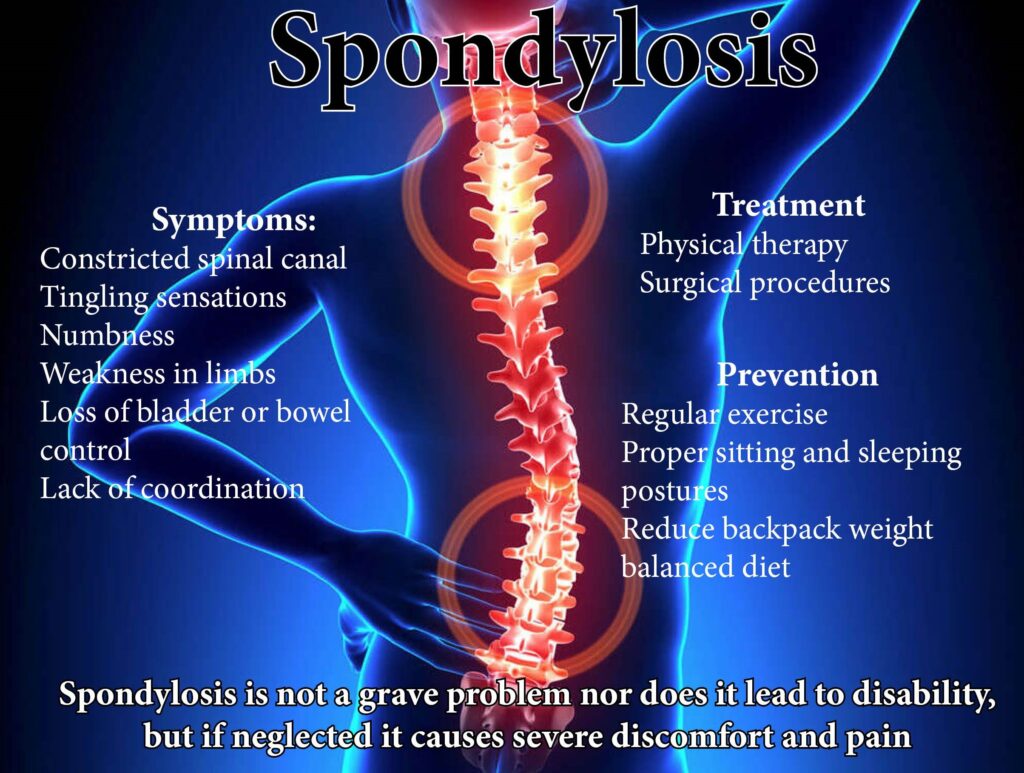Spondylosis is not a dire condition, nor does it inevitably lead to disability. However, when neglected, it can cause significant discomfort and pain.


Understanding the root cause of the problem is crucial. Spondylosis occurs when the abuse of the spine leads to a narrowing of the space between two adjacent vertebrae. This compression, in turn, affects the nerve roots emerging from the spinal cord, and in some cases, new bone development around small joints adds pressure, resulting in complications such as:
Dehydrated Disks: With age, spinal disks gradually dry and shrink, causing increased ‘on bone contact’ and heightened pain.
Herniated Disk: Cracks or ruptures in the exterior of the spinal disk can exert sharp pressure on nerve roots, leading to pain.
Bone Spurs: The body may develop extra bone in an attempt to strengthen the spine, potentially pinching spinal and nerve roots.
Stiff Ligaments: Aging causes ligaments, which connect bones, to stiffen and lose flexibility.
Recognizing Symptoms:
Most people may not experience debilitating pain until spondylosis becomes severe, as changes to the neck and spine may go unnoticed. Symptoms include a constricted spinal canal, tingling, abnormal sensations, numbness, weakness in limbs, loss of bladder or bowel control, lack of coordination, and pain in the neck, arms, shoulders, back, and legs.
Treatment Options:
The goal of treating spondylosis is to relieve pain, facilitate daily activities, and prevent permanent damage. Treatment varies based on severity and can involve physical therapy, including exercises to strengthen the neck and shoulders, or surgical procedures like Facetectomy, Foraminotomy, and Laminectomy for severe cases.
Preventive Measures:
A painless life is achievable through simple lifestyle alterations:
Regular exercise, including yoga and stretches, strengthens the backbone and helps prevent spondylosis.
Maintaining proper sitting and sleeping postures is crucial to avoid spinal issues.
Reducing the weight of backpacks or changing their positions frequently can alleviate spinal pressure.
A balanced diet, rich in omega-3 fatty acids and incorporating turmeric, ginger, and garlic, contributes to overall health.
While spondylosis is not a grave problem, neglecting it can lead to severe discomfort and pain. Adopting healthy habits, such as taking short walks, regular stretching, applying heat or cold for pain relief, and seeking medical attention when needed, are essential for maintaining spinal health.”
Dr. Chalapathy
Vydehi Super Specialty Hospital (VSH), Vittal
Mallya Road, Ashok Nagar, Bengaluru 500001
Ph: 080-22277979/9148972991
Vydehi Institute of Medical
Sciences & RC, White field, Bangalore – 560066
Ph : +91-80-4906 9000 Extn:1147/1366
www.vims.ac.in











